

Neoregelia ‘Len-Lynton Surprise’ . . . . . . . . Neoregelia ‘Bob’s Gift’ . .
October 2017


Neoregelia ‘Len-Lynton Surprise’ . . . . . . . . Neoregelia ‘Bob’s Gift’ . .
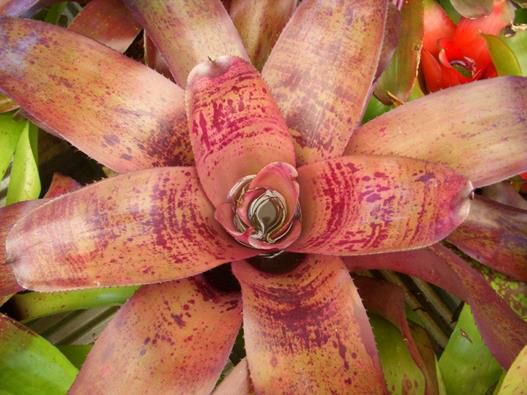

. . Neoregelia ‘Len-Lynton’ . . . . . . . . A grex mate of N. ‘Len-Lyntons’
Photographs by Neville Wood. See articles p.10
- Articles appearing in this issue of NEWSLINK are for information purposes only and are not necessarily endorsed by the Committee or the Illawarra Bromeliad Society.
- The Society is, by the holding of meetings, displays and competitions, to provide a forum for the people of the Illawarra region who are interested in the culture and collection of bromeliads.
- Under the provisions of the Privacy Act, use of names and references to private details, such as illness, holidays, birthdays and items of a similar nature, may only be published with the written permission of the person concerned.
NEWS IN BRIEF:
NEW MEMBERS:
A very warm welcome to our new members, Jan Thoroughgood, who joined in August and Joy Scholz who joined our Society in September. Also welcome back to Redelle and Terry Stedman who rejoined at our September meeting.
MONTHLY RAFFLE PRIZE ROSTER:
- October - Beth Clague, Barbara Jones-Beverstock, Ted Clare, Steve Wain
- November - Noel Kennon, Michael Drury, Deniece Crutchley, Maadi McKenna
- February 2018 - Fred Burrows, Monica De Clouett, Meri Stefanidakis, Maria Jakobsen
ROSTER FOR CLEANING UP AFTER THE MEETING:
As announced at the September meeting, a roster for cleaning up after the meeting is being introduced, starting with the October meeting. It is expected that each member will only be called on two or three times each year.
- October - Lesley Brand, Carol Burgdorf, Deniece Crutchley, Beverley Irvine, Bob Stephens, Les Thain, Heather Thain
- November - June Casey, Belinda Drury, Ann Kennon, Noel Kennon, Val Miller, Anne Mobbs, Brian Smith
- December - Everybody – Christmas Lunch
- February - Glenrae Barker, Christine Stephens, Gary Claydon, Colleen Claydon, John Toolan, Maureen Wheeler, June Smith
OCTOBER GARDEN VISITS:
The third and final round of garden visits for 2017 will be held on Saturday, October 21. We will start at the garden of Val Miller in Brownsville where we will have morning tea. Then on to the garden of Deniece Crutchley in Horsley and finally to Sandra Carnie in Albion Park Rail to see her garden and have lunch. Val and Sandra will provide tea and coffee and visitors are asked to bring cake and slice for all to enjoy. Detailed information about these visits will be circulated a few days before the event.
REMINDER - CHANGE OF ROOM FOR NOVEMBER MEETING:
As the Illawarra Lapidary Club’s annual exhibit requires the use of our usual meeting room in November, we will switch to the Scribbly Gum Room, located to the right of the main entry of the Centre, on the Princes Highway side of the building.
GENERAL MEETING – SATURDAY, NOVEMBER 4th: - “How to Identify Plants” by Graham Bevan.
NOVEMBER WORKSHOP:
The fourth and final Workshop for 2017 will be held on Saturday, November 18 at the home of Sharyn Baraldi, 25 Antrim Avenue, Warilla. We will start at 10 am and finish around 2pm with a Question and Answer session led by Neville Wood. Participants are asked to come prepared with questions about any aspect of the activities of the Society—plant sales, the Show, our competitions, our library, our meetings, growing broms, where to grow them, what happens in winter, what about frosts—and so on! Bring plants you want to ask about. Our experts will endeavour to give answers.
Sharyn will provide tea and coffee for morning tea and lunch and participants are asked to bring their own lunch and cake or slice to share.
CHRISTMAS PARTY:
This year’s Christmas party will be held in our usual meeting room—the Laurel Room—and will be a catered affair. Cost will be $20 per person (members/non-members) and will include a choice of carved meats, salads/vegetables and desserts. The Society will supply punch but wine and beer will be on a BYO basis. We will have access to the room from noon on Saturday, December 2 and so after time for setting up we have asked for lunch to be served at 12.45 pm. As in past years please bring a small gift for sharing (around the $10 mark)—with men bringing presents suitable for men and women bringing presents suitable for women—and bromeliads always welcome! Suzanne will need to have numbers and monies in by our November meeting—and/or numbers by November 15 at the latest.
LIBRARY NOTE:
Would members who have books, videos or journals out on loan please return them by our November meeting as this allows for any stocktake, repair, etc. during the Christmas break.
GENERAL MEETING – Saturday, February 3, 2018:
Noel Kennon will talk about three innovations for 2018: “Photographic Competition”; “Saving a Species”; and “Growing Challenge”, followed by a short talk by Neville Wood on “Caring for Seedlings”.
GARDEN VISITS FOR FEBRUARY 2018
We are planning garden visits in the Sutherland Shire for Saturday, February 17 which will include visits to Edwina and Steve’s and Sylvia and Ted’s lovely gardens. Further details will be provided in our January 2018 Newslink (and in Michael’s mail-out).
MARCH 10, 2018 SALES DAY
We are planning a sales day for Saturday, March 10 (open to the public from 9 am to 3 pm) to be held at the Warilla Neighbourhood Centre, located in the heart of Warilla, next to the Swimming Pool on Benaud Crescent. Access to Benaud Crescent is from Lake Entrance Road. More details will be available at our meetings before that date!
UPCOMING EVENTS :
| BERRY GARDENS FESTIVAL 10 am – 4 pm $20 for 8 gardens (may be used over the 4 days/$5 indiv. gardens. Free for children under 18. berrygardens.org.au | |
| BROMELIAD FAIR Concord Senior Citizens Centre, 9-11 Wellbank Street, Concord. Saturday 10 am – 4 pm/Sunday 9 am – 12 noon EFTPOS/VISA/MASTERCARD available | |
| HILLS DISTRICT ORCHIDS SUMMER OPEN DAY – 183 Windsor Road, NORTHMEAD. (Park in Mary Street or Windermere Avenue) 9 am-4 pm. (Also feel welcome to visit Ian Hook's Brom. garden at 6 Mary St - if he's home.) www.hillsdistrictorchids.com | |
| HILLS DISTRICT ORCHIDS AUTUMN OPEN DAY – See details above. | |
| WORLD BROMELIAD CONFERENCE – SAN DIEGO Paradise Point Resort on Mission Bay. Registration fee has been reduced to $US290 - www.bsi.org for further details. |
PLANT NAMES – WHY LATIN ?
From Paul T. Isley’s book, Tillandsia1: {Isley, Paul T. III (2009) Botanical Nomenclature, Pronunciation, & Taxony. In: Tillandsia II, Botanical Press, Redondo Beach, California}
“To quote the respected British botanist, William T. Stearn (1983), “Botanical Latin is best described as a modern Romance language of special technical application, derived from Renaissance Latin with much plundering of ancient Greek which has evolved, mainly since 1700 and primarily through the work of Carl Linnaeus (1707-78), to serve as an international medium for the scientific naming of plants in all their vast numbers and manifold diversity. The property of no one nation or linguistic group, Latin has, in consequence of its neutrality, become world-wide.”
“All plants, bacteria, and animals on earth are given latinized scientific binomials to individually differentiate species. … The International Code of Botanical Nomenclature (ICBN) regulates all decisions of nomenclature in botany. Strict rules govern the order in which the plants are named and how names are spelled.”
~~ Species names are always in Latin, not English, and comprise two parts (binomial): the genus, with first letter always capitalized and either underlined or written in italics; the second part (the specific epithet), is always written in lower case and underlined or italicized:
E.g., Tillandsia xiphioides or Tillandsia xiphioides.
~~ A hybrid/cultivar—also in two parts, with the genus written first, as above—and the given name written in single quotes and the first letter(s) given an initial capital. Since 1959 they must in a modern language—not Latin—and the cultivar name is never underlined or italicized.
E.g., Neoregelia ‘Amazing Grace’.
MONTHLY PLANT COMPETITION RESULTS:
July 1,: Plant Results
OPEN
1st = Lydia and Ian Chinnock = Dyckia
2nd = Lydia and Ian Chinnock = Guzmania
2nd = Noel Kennon = xSincoregelia ‘Firecracker’
3rd = Lydia and Ian Chinnock = Billbergia vittata
TILLANDSIA
1st = Michael Drury = stricta (thought to be ‘Cotton Candy’)
2nd = Noel Kennon = fuchsii forma gracilis
3rd = Noel Kennon = floribunda
August 5, PLANT RESULTS
OPEN
1st = Neville Wood = Neoregelia ‘Shelldance’
2nd = Noel Kennon = Vriesea carinata
3rd = John Toolan = Neoregelia ‘Orange Burstr’
3rd = Steve Wain = Billbergia ‘Bubblez’
NOVICE
1st = Pam Townsend = Nidularium procerum
2nd = Anne Mobbs = Guzmania
3rd = Pam Townsend = Billbergia nutans
TILLANDSIA and allies (Barfussia, Josemania, Lemeltonia, Racinaea, and Wallisia)
1st = Noel Kennon = punctulata
1st = Heather Thain = stricta (thought to be ‘Cotton Candy’)
2nd = Noel Kennon = ionantha
3rd = Steve Wain = propagulifera
September 2, PLANT RESULTS
OPEN
1st = Lydia Chinnock = xSincoregelia ‘Galactic Warrior’
2nd = John Toolan = Aechmea distichantha
3rd = John Toolan = Aechmea recurvata
NOVICE
1st = Anne Mobbs = Vriesea ‘Kitteliana’
TILLANDSIA
1st = Noel Kennon = ionantha
2nd = Graham Bevan = sprengeliana
3rd = Noel Kennon = stricta var. albifolia
CHAMPION BROMELIAD: OPEN
Lydia Chinnock = Dyckia
CHAMPION BROMELIAD: NOVICE
Heather Thain = Tillandsia stricta hybrid (perhaps ‘Cotton Candy’)
BEST SPECIES
John Toolan = Aechmea distichantha
DULCIE DOONAN MEMORIAL AWARD
Elizabeth Bevan = ‘Volcano Eruption’
CATHERINE (RENA) WAINWRIGHT MEMORIAL AWARD
Graham Bevan = Tillandsia recurvifolia
CATEGORY I – DIVISION I: HORTICULTURAL - OPEN
Class A - Aechmea (5 entries)
1st = John Toolan = Aechmea distichantha
2nd = John Toolan = Aechmea distichantha
3rd = John Toolan = Aechmea recurvata
Class B - Billbergia (3 entries)
1st = Neville Wood = Billbergia ‘Manda’s Othello’ X ‘Estrella’
2nd = Edwina Caruana and Stephen Wain = Billbergia ‘Bubblez’
3rd = John Toolan = Billbergia ‘Curly Top’ X leptopoda
Class C - Neoregelia (14 entries)
1st = Neville Wood = Neoregelia concentrica X ‘Bob’s Gift’
2nd = Neville Wood = Neoregelia ‘Royal Cordovan’
3rd = Neville Wood = Neoregelia ‘Orchid’ X concentrica
Class D - Miniature Neoregelia (7 entries)
1st = Bob Stephens = Neoregelia ‘Shamrock’
2nd = Edwina Caruana and Stephen Wain = Neoregelia ‘Aquarius’
3rd = Ted Clare = Neoregelia ‘Hot Embers’
Class E - Tillandsia (15 entries)
1st = Noel Kennon = Tillandsia punctulata
2nd = Noel Kennon = Tillandsia leonamiana
3rd = Graham Bevan = Tillandsia seleriana
Class F - Vriesea/Guzmania (13 entries)
1st = Edwina Caruana and Stephen Wain = Guzmania ‘Mini Revolution’
2nd = Ann Kennon = Goudaea ‘Tiger Tim’
3rd = Beverley and Laurie Irvine = Vriesea gigantea var. seideliana
Class G - Other Genera (14 entries)
1st = Lydia Chinnock = Dyckia
2nd = Elizabeth Bevan = Cryptanthus ‘Pink Starlight’
3rd = Noel Kennon = xSincoregelia ‘Galactic Warrior’
CATEGORY I – DIVISION II: HORTICULTURAL – NOVICE
Class L - Tillandsia (4 entries)
1st = Heather Thain = Tillandsia stricta hybrid
2nd = Belinda Drury = Tillandsia schiedeana ‘Major’
3rd = Belinda Drury = Tillandsia bulbosa
Class M - Vriesea/Guzmania (2 entries)
1st = Anne Mobbs = Guzmania hybrid
2nd = Belinda Drury = Vriesea ‘Evita’
Class N - Other Bromeliad (2 entries)
1st = Anne Mobbs = Goudaea ospinae
CATEGORY I – DIVISION III: HORTICULTURAL - DISPLAY AND MULTIPLE PLANTS
Class O Colony – Aechmea/Neoregelia/Vriesea (21 entries)
1st = Graham Bevan = Aechmea nudicaulis
2nd = Ted Clare = Neoregelia ‘Alley Cat’
3rd = Lydia Chinnock = Aechmea ‘Aztec Gold’
Class P - Mounted Tillandsias (2 entries)
1st = Maureen Wheeler = A tillandsia tree (on cholla cactus wood)
2nd = Noel Kennon = Tillandsia fuchsii forma gracilis
Class Q - Mounted Bromeliad (3 entries)
1st = Edwina Caruana and Stephen Wain = Aechmea orlandiana
2nd = Graham Bevan = Mini Neoregelias mounted on log
3rd = Edwina Caruana and Stephen Wain = Aechmea nudicaulis ‘Variegata’
CATEGORY II - ARTISTIC
Class R - Basket or Decorative Container (9 entries)
1st = Lydia Chinnock = ‘Soup Container Garden’
2nd = Belinda Drury = A large basket of colour
3rd = Elizabeth Bevan = Decorative Basket
Class S - Bromeliad Garden (10 entries)
1st = Lydia Chinnock = Wok Garden
2nd = Lydia Chinnock = Sleigh Garden
3rd = Lydia Chinnock = Giant Tennis Shoes Garden
Class T - Artistic Arrangement (2 entries)
1st = Elizabeth Bevan = ‘Volcano Eruption’
2nd = Lydia Chinnock = Watering Can Garden
COMPETITION STATISTICS
CRYPTANTHOID NAME CHANGES: Three new genera: Forzzaea, Hoplocryptanthus, Rokautskyia
Due to Leme et al in: Phytotaxa 318(1): 001-088, 2017 (Summary list compiled by Derek Butcher)
(Reprinted from Far North Coast Bromeliad Study Group September 2017 Newsletter)
Old Name - - - - - - - - > New Name
Cryptanthus - - - - - - - - > Forzzaea leopoldo-horstii
Cryptanthus - - - - - - - - > Forzzaea micra*
Cryptanthus - - - - - - - - > Forzzaea warasii
Cryptanthus . . . . . . . . . . . Hoplocryptanthus caracensis
Cryptanthus . . . . . . . . . . . Hoplocryptanthus ferrarius
Cryptanthus - - - - - - - - > Hoplocryptanthus glaziovii
Cryptanthus - - - - - - - - > Hoplocryptanthus lavrasensis
Cryptanthus . . . . . . . . . . . Hoplocryptanthus regius
Cryptanthus - - - - - - - - > Hoplocryptanthus schwackeanus
Cryptanthus - - - - - - - - > Hoplocryptanthus tiradentesensis
Cryptanthus . . . . . . . . . . . Rokautskyia aracruzensis
Cryptanthus . . . . . . . . . . . Rokautskyia caulescens
Cryptanthus . . . . . . . . . . . Rokautskyia exaltata*
Cryptanthus . . . . . . . . . . . Rokautskyia fernseeoides
Cryptanthus . . . . . . . . . . . Rokautskyia latifolia*
Cryptanthus . . . . . . . . . . . Rokautskyia microglazioui
Cryptanthus . . . . . . . . . . . Rokautskyia odoratissima*
Cryptanthus . . . . . . . . . . . Rokautskyia pseudoglazioui*
Cryptanthus . . . . . . . . . . . Rokautskyia pseudoscaposa*
Cryptanthus . . . . . . . . . . . Rokautskyia roberto-kautskyi
Cryptanthus . . . . . . . . . . . Rokautskyia sanctaluciae
Cryptanthus . . . . . . . . . . . Rokautskyia scaposa*
Cryptanthus . . . . . . . . . . . Rokaustskyia whitmanii
Laptanthus . . . . . . . . . . . Hoplocryptanthus vidaliorum
Indicates - - - - - - - - > those most affecting collections being grown in our FNCBSG NSW area that we know of which will need their labels changed.
*The opportunity has been taken to correct the Latin spelling and grammar of some species. Refer: http://botu07.bio.uu.nl/bcg/taxonList.php
SOME TILLANDSIA VARIETIES BECOME SPECIES
By Peter Waters (Reprinted from Bromeliad, J. BSNZI, September 2017, Vol. 57(9))
As if all the genera changes are not enough, just lately some former varieties and a subspecies of Tillandsia have been raised to the rank of species in their own right. This happens when a botanist decides there is sufficient difference in the variety to deserve its own specific status. These changes do make sense as in most cases there did not seem much similarity.
The variety Tillandsia tricolor var. melanocrater was raised to Tillandsia melanocrater a little while ago and you may be familiar with that, but some newer ones are as follows:
~ Tillandsia xiphioides ssp. prolata is now Tillandsia prolata
~ Tillandsia xiphioides var. tafiensis is now Tillandsia tafiensis
~ Tillandsia latifolia var. divaricata is now Tillandsia divaricata
And the latest is:
~ Tillandsia recurvifolia var. subsecundifolia which is now Tillandsia subsecundifolia (should save some label writing!)
WARMER WEATHER IS ON THE WAY: TIPS ON SPLITTING BROMELIADS FOR NEWER MEMBERS
(Reprinted from Bromeliad, J. BSNZI August 2017 Vol. 578 in turn adapted and reprinted from East London (South Africa) March 2017 newsletter.)
- You need to decide whether you are going to plant them in the garden, mount or pot them. You will need pots, potting medium, labels and a permanent marker. Each pup you split off its mother needs to be labelled.
- Bromeliads can start forming pups (or offsets) at any time, but start pupping after they bloom and then the mother plant slowly dies off over the next year or so, replacing itself with the pups.
- Most pups grow off the side of the mother plant at the base or on long woody stolons. Some plants, like Lutheria glutinosa and Lutheria ‘Splenriet’ have an axial pup coming out of the centre of the mother plant.
By removing pups you speed up the process of the mother plant producing more pups.
Then there are ‘grass pups’. These grow around the base of the mother and in the case of some alcantareas they are the only type of pup the mother produces. When big enough they can be carefully removed and grown on.
- Pups are ready to be separated when they reach about a third to half the size of the parent plant. If the pup is starting to form roots, that’s a good indication that the plant can survive on its own. They do not necessarily need to have roots to survive and begin life. They will form roots.
- Pups may be removed by cutting with a sharp knife or secateurs as close to the mother plant as possible. The bigger varieties may need a small saw to cut through the woody stem. Try not to damage the mother plant as it will probably produce more pups. Some pups can be pulled away from the mother by hand.
- The longer you leave the pups on the mother plant the quicker they will reach maturity (taking nourishment from mum). Position the plant with the pups facing towards the light. Alternatively, removing the pups when they are a bit smaller will encourage the mother plant to throw more pups sooner.
- Once pups are separated you can leave them for a few days in a shady spot for the ‘wound’ to heal or pot them up straight away, but don’t overwater them. Best to keep them on the drier side till roots form.
- Alternatively, if you have pups around the mother, you may choose to cut away the mother plant and let the pups form a clump.
- Some bromeliads, like neoregelias, look better separated so that the rosette form of the plant can be appreciated. Other genera—e.g., billbergias and tillandsias—often look better as a clump of specimen plants.
Saturday/Sunday November 11-12, 2017 |
20TH Australasian Bromeliad Conference |
NEOREGELIA ‘BOB’S GIFT’
(Formerly known as Neoregelia ‘Charm’ X ‘Cracker Jack’) (See cover picture)
Neville Wood, Illawarra Bromeliad Society Inc.
Some of our members may have a neoregelia in their collections carrying the formula name of Neoregelia ‘Charm’ X ‘Cracker Jack’.
I got this plant some years ago as a gift from a local grower called “Bob” at Barrack Point (I never did find out his surname) who bred it but never registered it. He wasn’t specifically a bromeliad grower but also grew orchids, African violets and other indoor plants, as well as a magnificent vegetable garden.
His main interest was general gardening but he was also very interested in hybridising. He made many crosses using various types of plants; however, this was his “one and only” bromeliad cross. He seemed pretty knowledgeable about neoregelias and he told me he thought this plant had “a bit of breeding potential “ and as I was interested and new to hybridising he showed me how to cross-pollinate a neoregelia flower, after which he gave me an advanced pup which he said was his only release.
Not long after, sadly, he passed away from a golden staph infection, following a leg amputation due to diabetes complications.
When the pup matured I used it in several of my early crosses and two plants from these crosses have since been registered as: Neoregelia ‘Dunmore Ruby’ and N. ‘Dunmore Delight’. Both have had success in our shows which goes to show that Bob’s prediction of “a bit of breeding potential” proved to be correct.
Thanks to Geoff Lawn the plant has now been registered as Neoregelia ‘Bob’s Gift’--see http://registry.bsi.org/?id=14102&whatsnew#14102 and if you have this plant you are encouraged to change the name tag.
NEOREGELIA ‘LEN-LYNTON SURPRISE’ (See cover picture)
Neville Wood, Illawarra Bromeliad Society Inc.
The first part of this plant’s name (“Len-Lynton”) comes from the name of the old family home of my grandparents who lived in Kiama. The name was made up from the names of two of their sons (my uncles), Len and Lynton, after they had both gone to the Boer War and the First World War respectively. Len died and never returned, fortunately Lynton did. As recognition of their service to our country, the home was named after them. I decided to also use this name for my plant to make it an ongoing living memorial.
I originally intended to name this plant ‘Len-Lynton’ but I realised I had previously used this name for another plant, so although I could still use this name I had to alter it in some way to avoid confusion.
The formula name for this cross was Neoregelia concentrica X (‘Charm’ X ‘Cracker Jack’) and almost all of the other siblings showed traces of either concentrica or ‘Charm’ X ‘Cracker Jack’.
Neoregelia ‘Len-Lynton Surprise’ was very different and I was very ‘surprised’ to see the multitude of different foliage colours so I added ‘Surprise’ to the end of the name and this is how Neoregelia ‘Len-Lynton Surprise’ got its name.
Ed. Note: Neoregelia ‘Charm’ X ‘Cracker Jack’ has since been registered as Neoregelia ‘Bob’s Gift’. As quite a number of the grex mates showed similarity to the concentrica and (‘Charm’ X ‘Cracker Jack’)—now called ‘Bob’s Gift’—parents, when compared, you can see why I was “surprised” to see the difference in foliage colour. I have asked Michael to show the various photographs which Neville has supplied to me so that you can get an idea of just why Nev was “surprised”!—Ed.


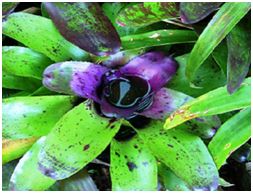
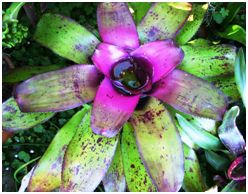


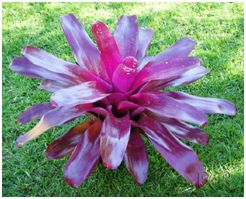


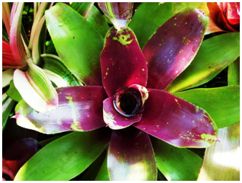
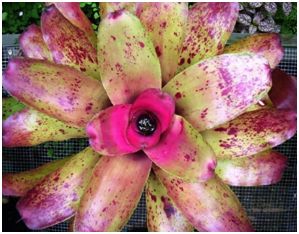

HANG UP YOUR BROMELS
By David Barry Jr.
(Reprinted from the Illawarra Bromeliad Society Inc.’s Newslink, January 1999 with the note: “I have taken these two articles on growing bromeliads in hanging baskets from September 1997 newsletters--the Central Coast NSW Bromeliad Society Inc.’s Bromelia Post {original article from a May-June, 1951 BSI Journal} and the second is from The Hunter District Bromeliad Society Inc.’s Newsletter.”)
Air plants need air, moving air. Some require more than others. Those that hold much water in their hearts, such as canistrums and nidulariums, are not as demanding in this respect as tillandsias of the xerophytic type; many hold no water and get moisture through peltate scales on the leaves.
It is exceedingly difficult, if not impossible, to maintain in good health under glass and pots resting on benches such specimens as, for example, Tillandsia argentea, T. caput-medusae, T. albida and T. festucoides. Such plants are easy to grow in good condition when placed in hanging positions in the house, where freedom of air movement around them is increased.
Hanging saves much bench space, is the best way to enjoy the beauty of such species with pendent spikes, such as Aechmea racinae and Vriesea scalaris, and is, in general, a method of increasing the ornamental appearance of plants in a glasshouse.
A treatment for ailing bromels is to hang them up. Without any change in culture a substantial improvement should soon be evident. Increased aeration is like a tonic. It also tends to offset effects of insufficient drainage in the potting material.
A sure way to root a bromeliad offshoot without losing it by rot is to pot it very firmly in osmunda fibre and to hang up the pot. The method is practically foolproof and is recommended for valuable plants. Do not overpot; better to underpot initially with this method.
With short, single wire hangers the hooks of several pot hangers may be inserted within the rim of a single pot already hanging, a space-saving, compact method; or pots may be hung in vertical series, each hooked over the vertical pot above.
The importance of air to bromels was notably evident in the plants grown in a glasshouse in Santa Barbara, California where a large electric exhaust fan in the gable of the house became activated whenever the temperature of the air rose above 780F (250C). The pots were arranged to permit ample and free air circulation around, above, and below them. Humidity was manually supplied by spraying around and between the pots and the floor.
The plants flourished with such incredible and unmatched vigour and beauty that it was difficult at first not to attribute this to some secret method or some special potting mixture, rather than identify the principal benefiting factor as air, moving air!
GROWING BROMELIADS IN HANGING BASKETS
Article and illustrations by G. Webber (Hunter District Bromeliad Society Inc.)
At the June 1997 meeting of the Hunter District Bromeliad Society the discussion topic was on hanging baskets for bromeliads, whereby some members brought in some examples. Several interesting points were brought out about why we actually bother to grow some broms in hanging baskets which may be of interest to readers as many do not seem to grow any broms in hanging baskets at all, but only in pots or in the garden. It appears that the favourite broms for hanging baskets were neoregelias, while some aechmeas also have a relevant reason to be grown in hanging baskets also. The following points were made:
1. Space Saving: While most of us grow our broms in pots on shelves or at floor level, hanging baskets allow an extra area below the roof level of the shade home for another suspended layer of plants.
2. Once again, Space Saving: Large neoregelias that have a very wide spread, such as N. cruenta, ‘Rosy Morn’ and pascoaliana, can be grown in hanging baskets as the long leaves extend far beyond the basket container. The resultant 3-4 feet of shelf space saved can be used for many other plants.
3. Dazzling Beauty Overhead: Some neoregelias, especially the speckled, marbled types such as ‘Charm’, marmorata, and ‘Beef Steak’ are quite drab when viewed from above at floor level. However, when hung up above eye level they emit a radiant beauty as light from overhead passes through their leaves, viewed from below.
4. Cluster Groups: There is no rule that a pot has to have only one plant in it. A large hanging basket allows a second generation group of 3 to 4 plants to reach maturity and display a spectacular show together.
5. Stoloniferous Plants: Many neoregelias produce colonies on branching stolons, as many miniatures do. A large, broad, hanging basket allows these to cluster across the surface and spill over the sides, such as ‘Fireball’, ‘Red of Rio’, ‘Tiger Cub’, ampullacea, etc.
6. Cascading Plants: Other small neoregelias, such as pendula and pauciflora, produce long stolons and cascading groups of plants. Hanging baskets, hung up high, are ideal for these.
7. Cascading Flower Stems: Various aechmeas produce large groups of interconnected plants with long, cascading flower stems that hang below the base of the plant—such as A. ‘Foster’s Favorite’, lasseri, filicaulis, racinae and victoriana—where hanging baskets are best suited for them either hung at eye level or above.
8. Hung in Trees: If planted in hanging baskets, it allows us to suspend them in trees, hung from branches at different levels by extension wires to give a “jungle-y” look, or more “natural” bromeliad garden appearance, as seen in nature. For those of us who mount broms directly to trees, if in baskets instead less watering is needed to keep them alive, as drying out is less around the root zone.
